When winter comes, many animals go into hibernation and the plants begin to change. Some species remain the same while others may wilt, or their leaves change colors.
It is during this cold period when holiday seasons happen. You may begin to wonder what it would take to make your landscape or lawn look better, especially if you’re having your relatives and friends over for a gathering.
Believe it or not, there are several species of beautiful flowers that bloom prolifically during the cold months.
That said, we have listed the eleven most beautiful winter-blooming flowers that you can plant around your house.
Table of Contents
1. Winter Heath (Erica carnea)

Winter heaths are indigenous to western, southern, and central Europe. They are also known as the December Red, Snow Heath, and Alpine Heath.
These evergreen shrubs can be recognized by their pinkish to purplish tube-shaped flowers, needle-shaped leaves, and dark green to brown slender stems.
Winter Heaths grow between six inches and one foot tall and spread between one and two feet wide.
The flowers of these plants bloom in the winter, particularly from the start of January until April, and attract insect pollinators such as bees.
There is a mutual relationship between bees and winter heath, in which the bees receive nectar while helping these plants in pollination.
These low-growing shrubs thrive in hardiness zones 5 to 7. They also need exposure to full sun and love moist, slightly acidic, and well-drained soil.
2. Black Tulip (Tulipa ‘Queen of the Night’)
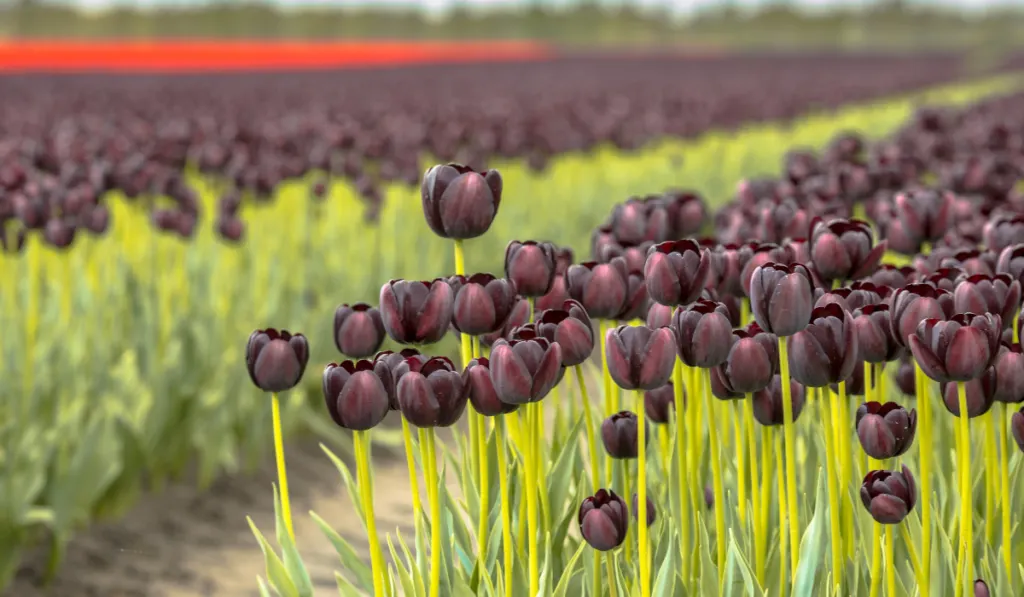
These majestic-looking flowers would certainly attract people who have a penchant for mysterious and dark-looking plants. They are also known as ‘Queen of the Night’ tulips.
Black tulips can be distinguished by their dark maroon or deep purplish flowers, green leaves, and slender green stems.
These plants generally grow between 20 and 24 inches tall with a width between four and six inches. They thrive in the hardiness zones 2 to 8 and are highly toxic to humans and pets.
If you’re planning to plant these bulbs, handle them with care and caution. Like most bulbs, black tulips are best planted in moist, well-drained soil under full sun.
3. Crocus (Crocus sativus)
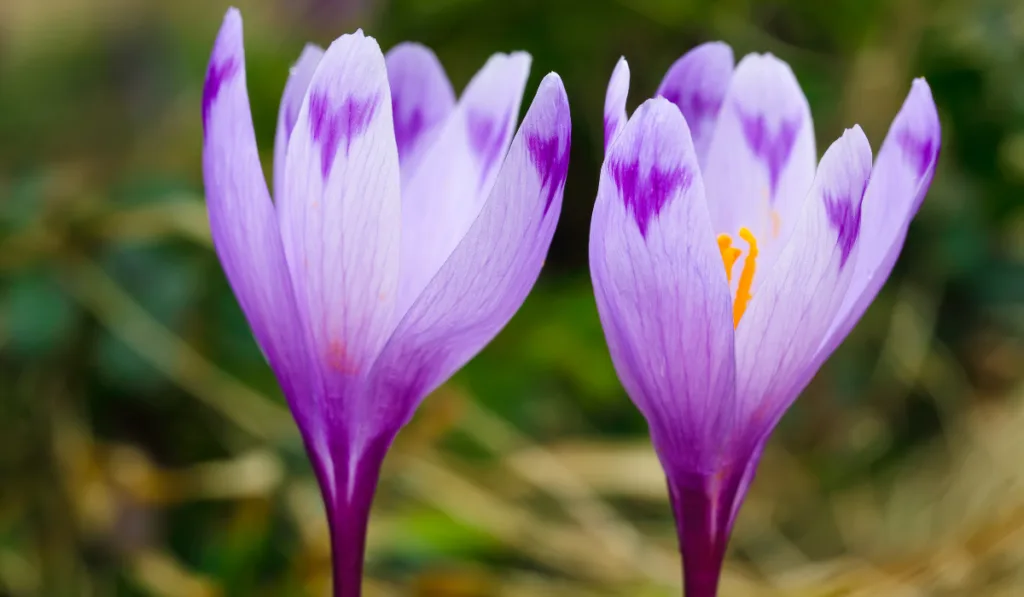
Crocus is a great late winter flower that you can add to your garden collection.
They are native to Europe, Asia, and North Africa.
These perennial bulbs can be distinguished by their bulb-shaped, five-petaled flowers and slender, tiny green leaves.
Based on their varieties, crocus flowers come in colors including lavender, yellow, purple, cream, white, pink, and blue.
These plants typically grow between three and six inches and spread between one and three inches wide. Crocus flowers thrive in hardiness zones 3 to 8.
They prefer moist, well-drained soil and can tolerate partial or full sun. These flowers are also toxic and should always be kept away from pets and children.
Being winter-loving plants, you won’t want to plant Crocus in hotter regions because they won’t last for long.
4. Winter Pansies (Viola heimalis)
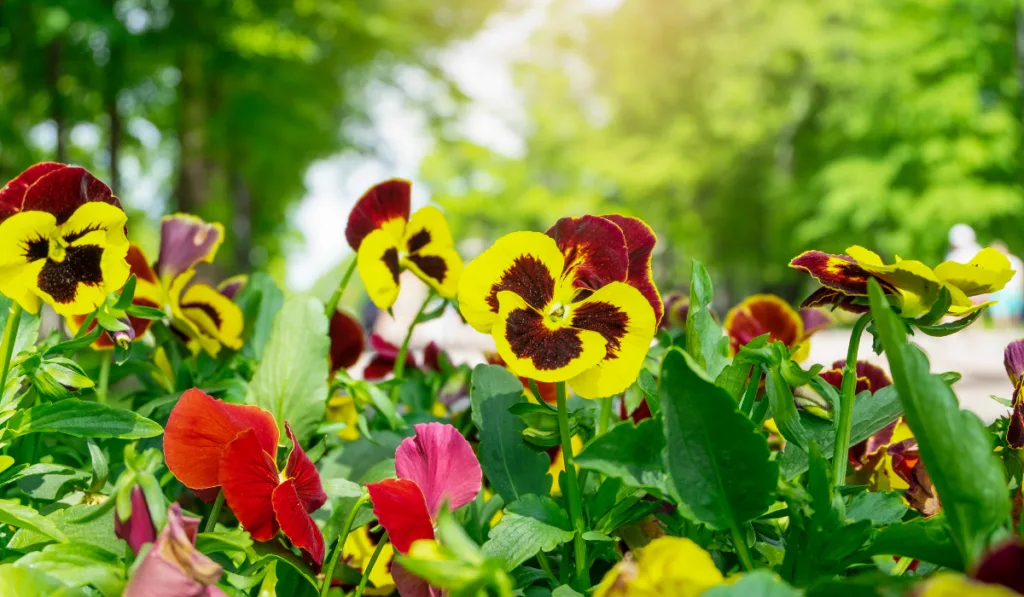
There are a few varieties of pansies but if you’re looking to grow one in the winter, then winter pansies would be your best choice.
These flowers are also known as Ice Pansies or winter flowering. Winter pansies generally grow between six and 10 inches tall and spread between nine and 12 inches wide.
These low-growing plants are easily recognized by their five-petaled flowers that come in assorted colors such as red, yellow, white, purple, blue, black, pink, and a mix of any of these colors.
Winter pansies grow well in hardiness zones 4 to 10. They can tolerate partial or full sun but always prefer moist and well-drained soils.
These plants also need proper maintenance from time to time. This includes deadheading the flowers to ensure that they bloom properly from one season to another.
5. English Primrose (Primula vulgaris)
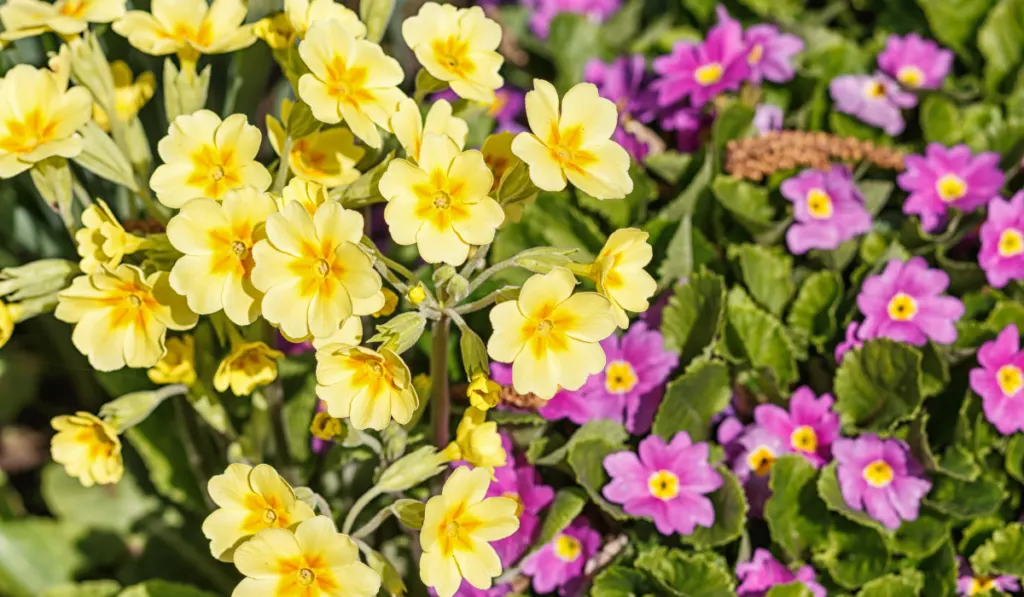
English primroses are indigenous to southern and western Europe. They typically grow between four and six inches tall and spread between four and nine inches wide.
These perennials are characterized by their oval-shaped, jagged-edged green leaves, and bi-color, whitish cream flowers that are made up of six petals.
Other varieties also come in various colors including orange, lavender, red, purple, and pink. English primroses grow in hardiness zones 5 to 10.
The flowers produce a fragrance that attracts insect pollinators such as bees and butterflies. These plants also prefer partial sun and moist, well-drained soil.
Due to being toxic, you should always keep them away from pets and children.
6. Snowdrop (Galanthus nivalis)
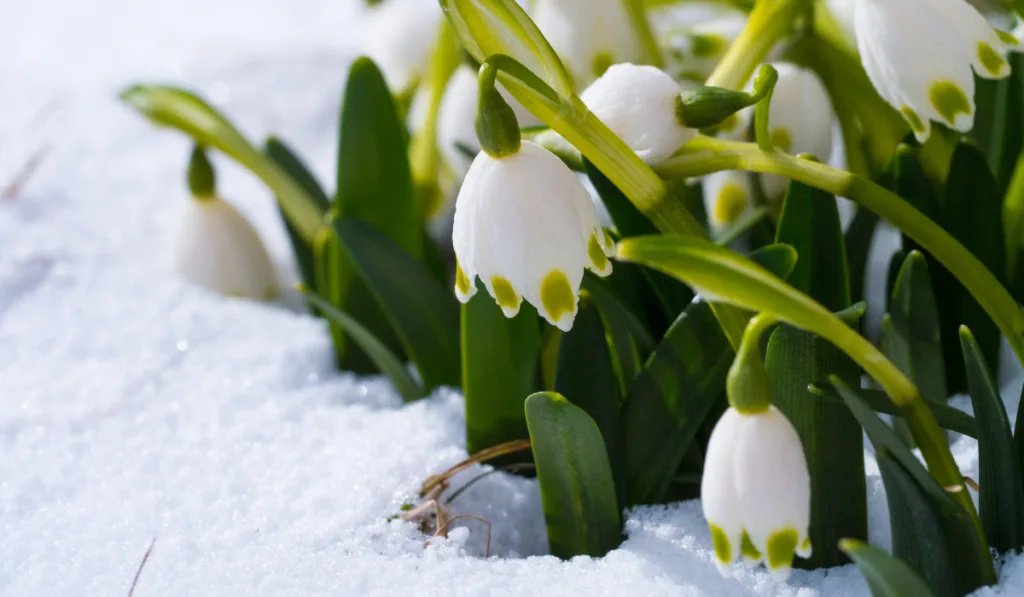
As their name states, Snowdrops are an appropriate winter-blooming flower that you can plant around your house. These small perennial bulbs are native to eastern Europe and western Asia.
Snowdrops can be characterized by their bulb-like flowers with six white petals, long and slender stems, and needle-like green leaves.
They grow between three and six inches tall and appear in the late winter or early spring. These plants thrive in hardiness zones 3 to 7.
Snowdrops prefer moist, well-drained soil and can tolerate partial or full sun. These plants are also considered toxic.
7. Camellia (Camellia spp.)
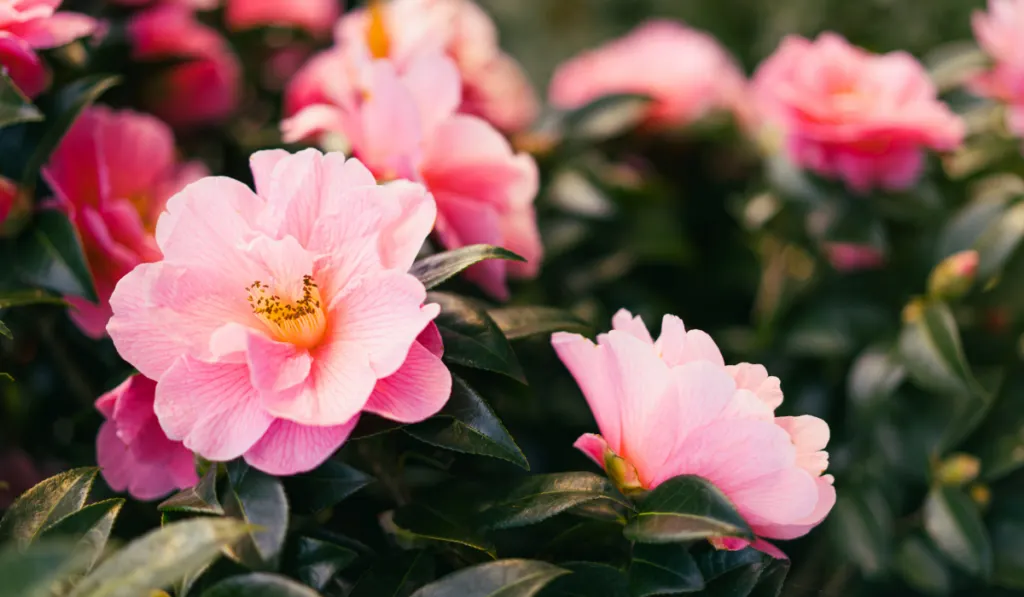
Camellias are native to Asia, particularly in Japan, Korea, and China.
These evergreen shrubs are recognized by their oval-shaped green leaves and thick, peony-like flowers that come in colors such as pink, red, lavender, white, and yellow.
They grow between two and twelve feet tall with a width between two and ten feet. Camellias thrive in hardiness zones 6 to 9 and start blooming from fall into spring.
They prefer slightly acidic, moist, and well-drained soil, and perform best under partial sun.
All you need to keep Camellias healthy is regular pruning from time to time to remove dead leaves or flowers.
8. Glory of the Snow (Chionodoxa forbesii)

Glory of the Snow or Chionodoxa is indigenous to the mountainous regions in western Turkey.
These low-growing perennials are easily distinguished by their long and narrow green leaves, thick short stems, and six-petaled flowers that come in different colors such as white, pink, and blue.
There are also a few other varieties of the same species that you might like including Lesser Glory of the Snow, Loch’s Glory of the Snow, and Crete Glory of the Snow.
Chionodoxas thrive in hardiness zones 3 to 8. They can tolerate partial or full sun and love moist but well-drained soil.
On average, these plants grow around six inches tall and spread between three and six inches wide. With their small size, you can plant them in a garden bed or container.
They can brighten up your house, in case you’re looking for smaller indoor plants.
9. Ipheion (Ipheion uniflorum)

Ipheions are also known as Spring Starflowers and Mexican Stars. These bulbous perennials are native to South American regions, particularly Argentina and Uruguay.
They have long, grass-like green leaves, slender stems, and six-petaled flowers that come in either white, pink, or bluish violet.
Ipheions typically grow between three and six inches tall with the same spread.
They start appearing in the middle or late spring and bloom for about eight weeks. These plants prefer moist, well-drained soil and can tolerate partial or full sun.
Another interesting trait of Ipheions is the onion-like fragrance produced by their leaves. So, don’t panic if you notice that these plants smell slightly more pungent than a typical flower.
10. Witch Hazel (Hamamelis virginiana)
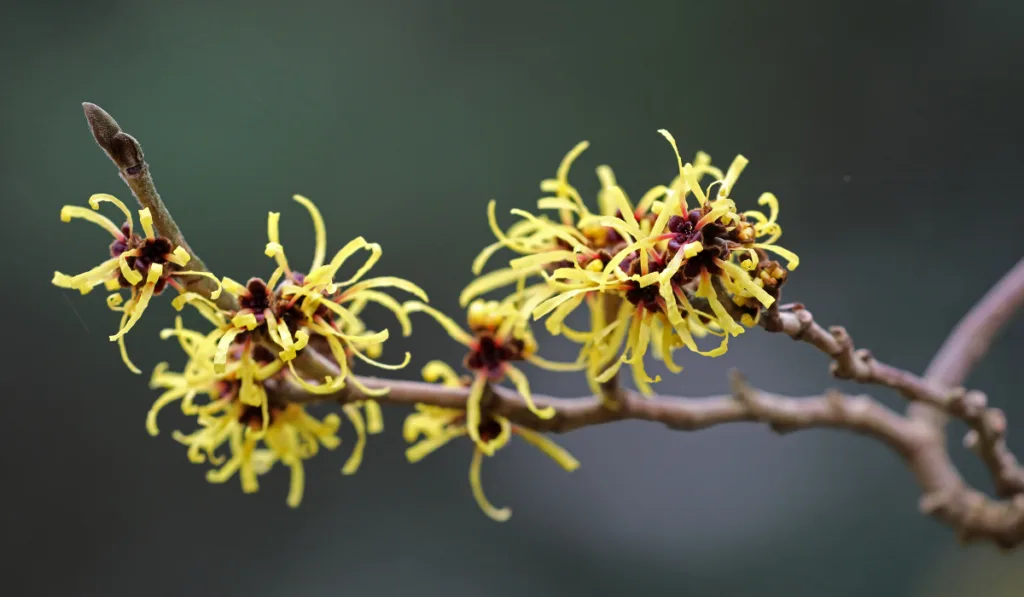
Witch Hazel is native to regions in eastern North America, specifically in Canada and Mexico.
They are also known as Winterbloom, Water-witch, Common Witch Hazel, Spotted Alder, Striped Alder, and Snapping Hazelnut.
This medium to large-sized deciduous shrub typically grows between 15 and 20 feet with the same spread.
They can be recognized by their crumpled, fragrant yellow flowers, green leaves, and thick, light brown bark. Their leaves also change to gold or yellowish-brown color in the fall.
Witch Hazels thrive in the hardiness zones 3 to 8. They prefer moist, slightly acidic soil and can tolerate partial or full sun.
Being a hardy species, they are highly resistant to cold temperatures, especially during winter.
Witch Hazel plants are grown for their medicinal properties.
They can help in reducing rashes, burns, and other skin problems.
11. Winter Aconite (Eranthis hyemalis)
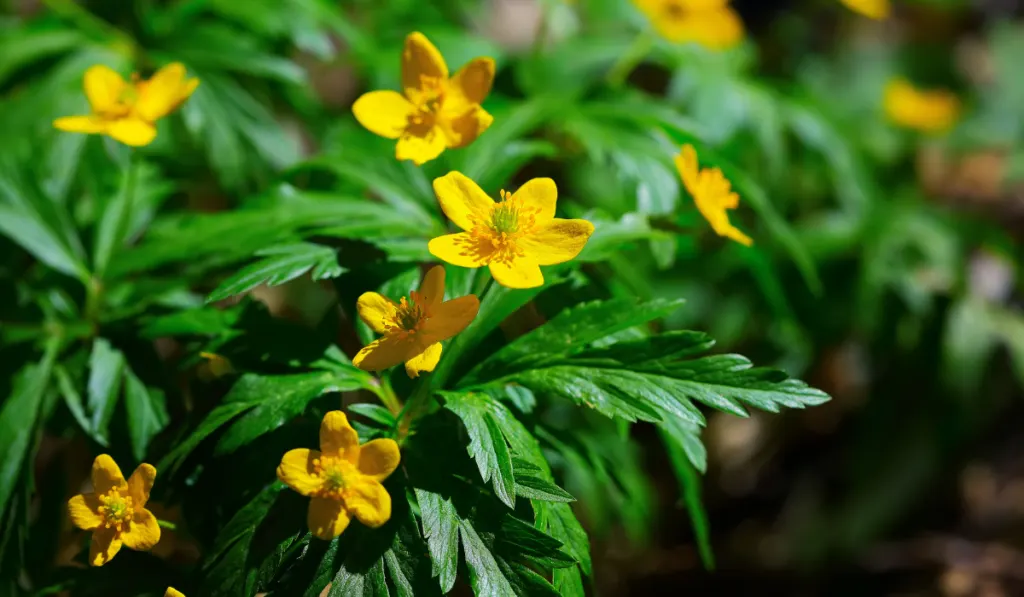
These low-growing perennials are indigenous to Europe and Asia. They are also known as the Winter Wolf’s Bane, Winter Hellebore, and Aconitum hyemale.
Winter aconites can be distinguished by their narrow green leaves that are parted in the middle and cup-shaped, six-petaled flowers.
These plants also grow between three and six inches tall with a width of around six inches. Winter aconites mainly grow in hardiness zones 4 to 9.
They prefer moist but well-drained soil and can be planted in shade or a sunny area. Being low-growing bulbous plants, they can be grown within groundcovers or your lawn or raised in garden beds.
Final Thoughts
Some of these flowers are best planted outside while others can be grown both indoors and out.
Depending on your choice, location, and the space you can spare, pick the ones that cater to your needs and can thrive in any place you put them.
If you want to go the extra mile, pair them with other fall and spring-flowering species. This way, you can make sure that your house is full of color throughout the year!
Resources
- https://plantura.garden/uk/trees-shrubs/erica-carnea/erica-carnea-overview
- https://www.gardenia.net/plant/erica-carnea-december-red-winter-heath
- https://www.highcountrygardens.com/flower-bulbs/tulip-flower-bulbs/tulipa-queen-of-the-night-black-tulip-bulbs
- https://www.brecks.com/product/Queen_of_Night_Tulip
- https://www.thespruce.com/planting-and-caring-for-crocus
- https://www.gardendesign.com/flowers/crocus.html
- https://spokengarden.com/winter-pansies
- https://gardenerspath.com/plants/flowers/winter-pansies/
- https://www.gardenia.net/plant/primula-vulgaris
- https://pfaf.org/user/Plant.aspx?LatinName=Primula+vulgaris
- https://www.thespruce.com/flower-facts-about-snowdrops
- https://plants.ces.ncsu.edu/plants/galanthus-nivalis/
- https://www.gardenia.net/guide/cold-hardy-camellias
- https://www.thespruce.com/camellia-flowers
- https://www.bhg.com/gardening/plant-dictionary/bulb/glory-of-the-snow/
- https://www.gardeningknowhow.com/ornamental/bulbs/glory-of-the-snow/glory-of-the-snow-bulbs.htm
- https://plants.ces.ncsu.edu/plants/ipheion-uniflorum/
- https://www.gardenia.net/plant-variety/ipheion-spring-starflower
- https://www.wildflower.org/plants/result.php?id_plant
- https://www.missouribotanicalgarden.org/PlantFinder/PlantFinderDetails
- https://www.gardenia.net/plant/eranthis-hyemalis-winter-aconite
- https://hort.extension.wisc.edu/articles/winter-aconite-eranthis-hyemalis/
